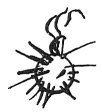
The Da Vinci Notebooks at sacred-texts.com
Of Greek fire.Take charcoal of willow, and saltpetre, and sulphuric acid, and sulphur, and pitch, with frankincense and camphor, and Ethiopian wool, and boil them all together. This
fire is so ready to burn that it clings to the timbers even under water. And add to this composition liquid varnish, and bituminous oil, and turpentine and strong vinegar, and mix all together and dry it in the sun, or in an oven when the bread is taken out; and then stick it round hempen or other tow, moulding it into a round form, and studding it all over with very sharp nails. You must leave in this ball an opening to serve as a fusee, and cover it with rosin and sulphur.
Again, this fire, stuck at the top of a long plank which has one braccio length of the end pointed with iron that it may not be burnt by the said fire, is good for avoiding and keeping off the ships, so as not to be overwhelmed by their onset.
Again throw vessels of glass full of pitch on to the enemy's ships when the men in them are intent on the battle; and then by throwing similar burning balls upon them you have it in your power to burn all their ships.
281:628 : Venturi has given another short text about the Greek fire in a French translation (Essai Section XIV). He adds that the original text is to be found in MS. B. 30 (?). Libri speaks of it in a note as follows (Histoire des sciences mathematiques en Italie Vol. II p. 129): La composition du feu gregeois est une des chases qui ont ete les plus cherchees et qui sont encore les plus douteuses. On dit qu'il fut invente au septieme siecle de l'ere chretienne par l'architecte Callinique (Constantini Porphyrogenetae opera, Lugd. Batav. 1617,-- in-8vo; p. 172, de admin, imper. exp. 48), et il se trouve souvent mentionne par les Historiens Byzantins. Tantot on le langait avec des machines, comme on lancerait une banche, tantot on le soufflait avec de longs tubes, comme on soufflerait un gaz ou un liquide enflamme (Annae Comnenae Alexias, p. 335, lib. XI.--Aeliani et Leonis, imperatoris tactica, Lugd.-Bat. 1613, in-4. part. 2 a, p. 322, Leonis tact. cap. l9.--Joinville, histoire du Saint Louis collect. Petitot tom. II, p. 235). Les ecrivains contemporains disent que l'eau ne pouvait pas eteindre ce feu, mais qu'avec du vinaigre et du sable on y parvenait. Suivant quelques historiens le feu gregeois etait compose de soufre et de resine. Marcus Graecus (Liber ignium, Paris, 1804, in-40) donne plusieurs manieres de le faire qui ne sont pas tres intelligibles, mais parmi lesquelles on trouve la composition de la poudre a canon. Leonard de Vinci (MSS. de Leonard de Vinci, vol. B. f. 30,) dit qu'on le faisait avec du charbon de saule, du salpetre, de l'eau de vie, de la resine, du soufre, de la poix et du camphre. Mais il est probable que nous ne savons pas qu'elle etait sa composition, surtout a cause du secret qu'en faisaient les Grecs. En effet, l'empereur Constantin Porphyrogenete recommende a son fils de ne jamais en donner aux Barbares, et de leur repondre, s'ils en demandaient, qu'il avait ete apporti du ciel par un ange et que le secret en avait ete confie aux Chretiens (Constantini Porphyrogennetae opera, p. 26-27, de admin. imper., cap. 12).